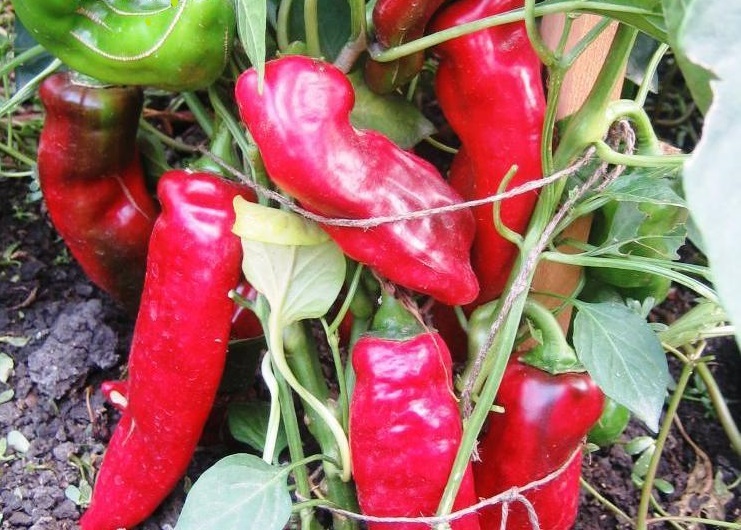 This is one of the popular varieties of sweet pepper, which is common when grown among gardeners. It has a pleasant taste and delicate aroma.
This is one of the popular varieties of sweet pepper, which is common when grown among gardeners. It has a pleasant taste and delicate aroma.
Content
- 1 Characteristics and description of the variety
- 2 Advantages and disadvantages of the variety
- 3 Features of cultivation and care of the variety
- 4 The main purpose of the variety
- 5 Reviews of those who planted
- 6 What regions are grown
- 7 Resistance to disease and adverse conditions
- 8 Storage rules
- 9 The benefits and harms of eating pepper
Characteristics and description of the variety
To have an idea when choosing a variety, you must carefully study its description. But the seeds of this pepper are rarely found on sale and therefore people got out of the situation - they get pepper in supermarkets and, having used the fruit for its intended purpose, leave the seeds for propagation.
Productivity
Productivity from one bush can reach 2 kg, since up to 12 pieces of large fleshy fruits grow on a bush.
IMPORTANT! To get such a crop, you must adhere to the rules of cultivation and in time feed pepper with special fertilizers.
Also find out Fakir Pepper Characterization.
Height, plant weight, color, shape
This variety can be easily distinguished from others by carefully studying its external description:
- the shape of the fetus is elongated and narrow compared to length;
- the length of the fetus is 30 cm;
- diameter up to 4 cm;
- grows up to 12 large fruits on one bush;
- the wall thickness of the fetus is 6 mm;
- the weight of one fetus can be in the range of 100-150 gr.;
- has a sweet catchy taste.
The color of the fruit may vary depending on the ripening period.
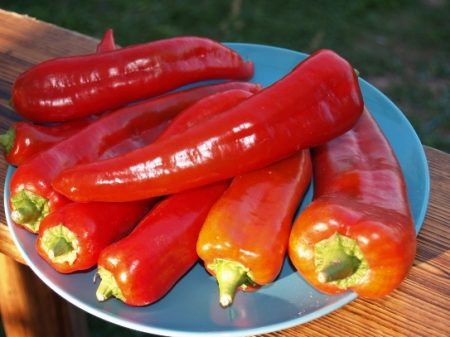
IMPORTANT! Thanks to its description, the variety is easily recognizable and in demand by people.
Fruit ripening speed
The variety is rather late ripening. For full fruit ripening, it needs 105 days from the moment of seed germination.
Seedling planting dates
Seeds are planted for seedlings in late February, if the gardener has a greenhouse, they are sown 15 days earlier.
Advantages and disadvantages of the variety
This variety has many advantages:
- large bushes with numerous ripening fruits;
- it ripens well in the greenhouse;
- fruitful;
- excellent taste;
- the pulp is juicy and sweet.
Of the disadvantages, only that pepper should be grown only through seedlings.
Features of cultivation and care of the variety
So that the seeds are pleased with their germination, they are first tested for their ability to grow. Seeds are put in salted water and those that have surfaced are unsuitable for growing seedlings, since they are dead; there is no embryo from which a seedling of pepper will develop.
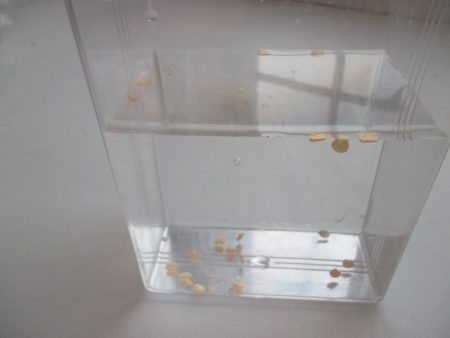
Then the remaining seeds are disinfected with a pink solution of potassium permanganate. To do this, they are soaked for a couple of hours in solution. After these procedures, the seeds are ready for sowing.
IMPORTANT! These two procedures should not be skipped, as the seeds may be dead and then waiting for the sprouts will be in vain.
Finished seeds are sown in pots filled with a nutritious and loose substrate. Soil can be purchased at a flower shop or compiled yourself. For their own soil, they take everything in equal shares:
- turf land;
- sand;
- humus or earth from a compost heap.
Before use, the earth is disinfected in any convenient way. For example, they freeze in the freezer of the refrigerator during the day.
IMPORTANT! The bowl should have drainage holes to drain excess water after irrigation.
When the bowl and the ground are ready to irrigate by immersing the bowl in warm water.When the ground is saturated with warm water, we make shallow holes up to 2 mm and plant prepared seeds.
At this point, you need to cover the bowl with the seeds sown with clear glass or a plastic bag to create a moist greenhouse environment. This will give more friendly seedlings of sweet pepper seedlings.
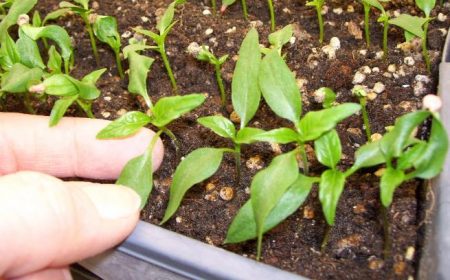
The bowl should be in a room with a temperature of +25 degrees. At lower temperatures, seeds may not sprout.
When most seeds hatch, the shelter is removed and the bowl is exposed on a light windowsill. If this is not available, then it will be necessary to arrange for the growing seedlings of sweet pepper additional illumination with the help of special incandescent lamps.
The grown seedlings need a dive and when it already has two true leaves on it, it is planted in separate cups up to 500 g.
Further care seedlings will consist of:
- watering;
- rotations with different sides in relation to the sun (so that the plant does not fall on one side).
Before planting in open ground, seedlings must be quenched for 10 days. This will help her adapt well in a new place.
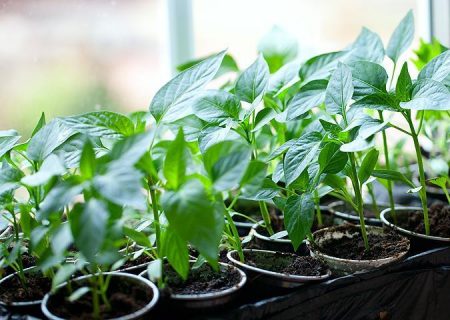
IMPORTANT! Seedlings are planted in the morning in cloudy weather or in the evening. This will give her time to take root in a new place.
The main purpose of the variety
Ramiro pepper is used in cooking, it:
- bake in the oven.
- used in the preparation of sauces and lecho.
- used in the preparation of first courses.
Reviews of those who planted
Olga
From the purchased pepper, I selected the seeds, selecting only equal, marketable products. At the end of winter, checking for germination, planted on seedlings. Pepper was a success. In the summer, he pleased me with the same fruits that I bought at the store. This suggests that this is a variety, not a hybrid. The taste of the fruit was wonderful - sweet, aromatic and juicy.
Peter
After reading various reviews, I found this pepper in the store and collected the seeds. At first, I thought it was a kind of Chile. But I am very pleased with the grown fruits - they are sweet and fleshy. Salads from it are just wonderful. And his wife is preparing a wonderful night for the winter.
Galina
This pepper is much tastier than those sold in our stores in the winter. But it is still poorly kept at my home. And yet, until the New Year, I can please myself and my friends with the fruits of this delicious bell pepper.
What regions are grown
Sweet pepper is cultivated in all regions of the country. But only in the south, in the Krasnodar Territory, it is grown on a large scale for sale in markets and for its participation in various harvesting at canneries in Russia. The north the cultivation region, the shorter the summer. But gardeners in their private, not large areas manage to grow bell peppers even in the Moscow region. It’s just that in such regions it requires shelter in early June from return frosts, and at the end of August it is covered, since strong cooling is possible at night, and you need to monitor the night temperature.
IMPORTANT! When cultivating pepper in the northern regions, you must have a film shelter or a greenhouse.
Resistance to disease and adverse conditions
Peppers of this variety can get sick with a columnar - with this disease, the leaf plates begin to turn yellow and eventually dry out. In this case, the fruits grow irregularly shaped. The carriers of this disease are insects that have adapted to feed on plant sap.
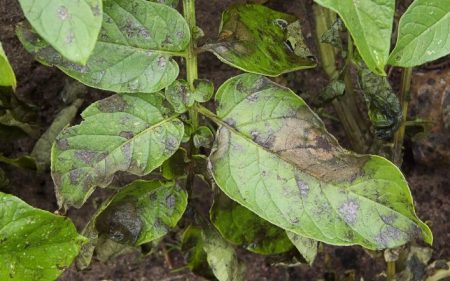
To get rid of this disease, you need to treat the bushes with special chemicals that are sold in stores.
Storage rules
To keep the pepper for a long time, you must follow these recommendations:
- collect pepper in technical maturity;
- select only good quality fruits for storage without damage;
- the room where the pepper will be stored should be at a temperature of +7 degrees.
IMPORTANT! Ramiro variety is poorly stored and if it is not enough, then it is better to cut it and freeze it in a refrigerator in the freezer, spreading it in a thin layer in transparent plastic bags.
The benefits and harms of eating pepper
With the regular use of sweet pepper, it positively affects the health of the human body. It contains various antioxidants that are:
- thin the blood.
- participate in blood renewal.
- increases hemoglobin.
- contains many vitamins.
- positively affects the nervous system in depression and nervous breakdowns.
People with diseases of the gastric system cannot consume pepper fruits in large quantities. It is also contraindicated in pregnant and lactating mothers.




 Calorie pepper stuffed with meat and rice - BZHU per 100 grams
Calorie pepper stuffed with meat and rice - BZHU per 100 grams Gorky pepper - the best varieties for open ground
Gorky pepper - the best varieties for open ground Hot pepper seeds - the best varieties for open ground and reviews
Hot pepper seeds - the best varieties for open ground and reviews Capsicum tincture for hair - how to use and reviews
Capsicum tincture for hair - how to use and reviews